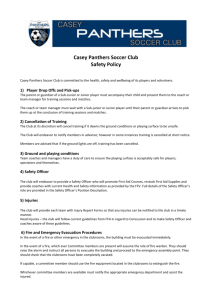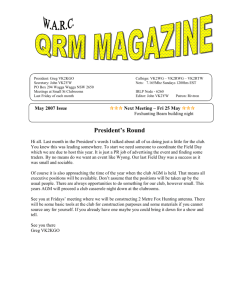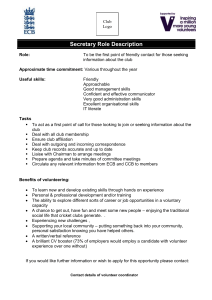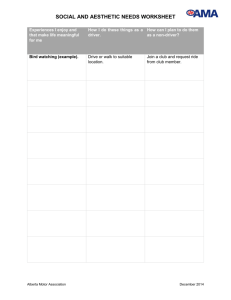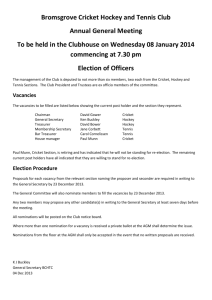f.h.c. history (a small part of)
advertisement
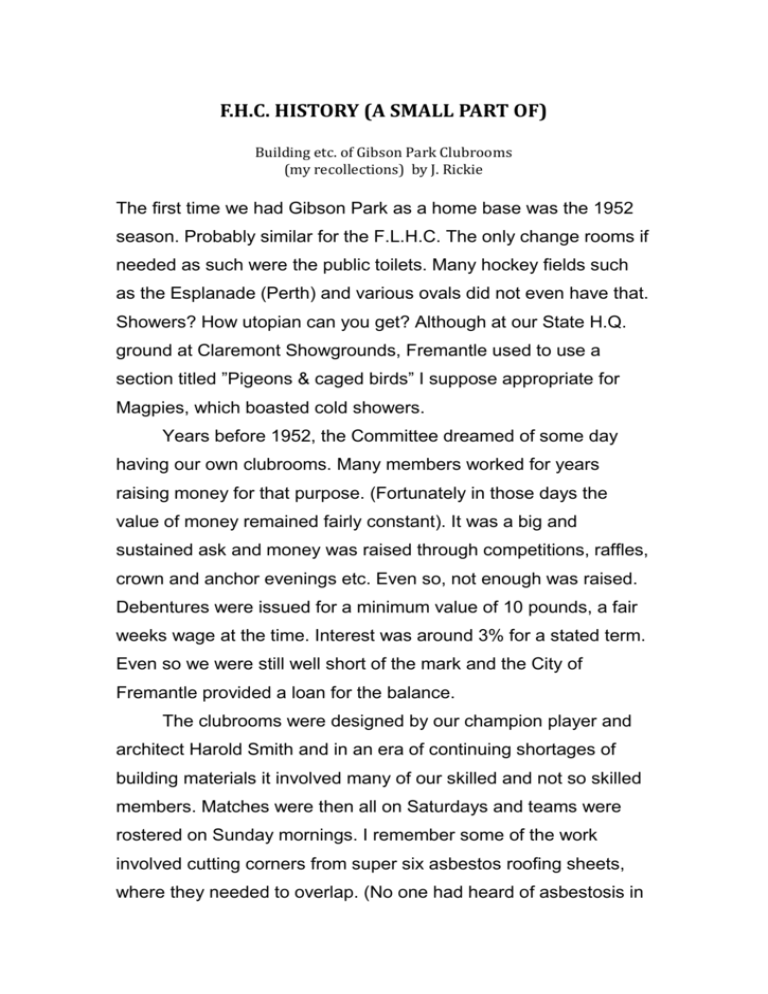
F.H.C. HISTORY (A SMALL PART OF) Building etc. of Gibson Park Clubrooms (my recollections) by J. Rickie The first time we had Gibson Park as a home base was the 1952 season. Probably similar for the F.L.H.C. The only change rooms if needed as such were the public toilets. Many hockey fields such as the Esplanade (Perth) and various ovals did not even have that. Showers? How utopian can you get? Although at our State H.Q. ground at Claremont Showgrounds, Fremantle used to use a section titled ”Pigeons & caged birds” I suppose appropriate for Magpies, which boasted cold showers. Years before 1952, the Committee dreamed of some day having our own clubrooms. Many members worked for years raising money for that purpose. (Fortunately in those days the value of money remained fairly constant). It was a big and sustained ask and money was raised through competitions, raffles, crown and anchor evenings etc. Even so, not enough was raised. Debentures were issued for a minimum value of 10 pounds, a fair weeks wage at the time. Interest was around 3% for a stated term. Even so we were still well short of the mark and the City of Fremantle provided a loan for the balance. The clubrooms were designed by our champion player and architect Harold Smith and in an era of continuing shortages of building materials it involved many of our skilled and not so skilled members. Matches were then all on Saturdays and teams were rostered on Sunday mornings. I remember some of the work involved cutting corners from super six asbestos roofing sheets, where they needed to overlap. (No one had heard of asbestosis in those days.) We had many great clubmen, too many to mention or maybe remember. Eventually they were finished and officially opened one Saturday afternoon, probably 1955, by the Mayor of Fremantle, who cut the tape in front of the doors. Dick Faulds had a movie film of the event and part of a game, which I saw about a year later. The cost of the building or other financial details are not known although some details may appear in Club Minutes around 1954/5. Dick Faulds was Treasurer of the then ‘Hudson Account” which covered all aspects of the clubrooms including hire revenue and outgoing costs. He did verbally report to the Committee on finances but there were no annual statements or other reports published as far as I know. He wanted me to take over the Hudson Account in the early 1960’s, but I was not keen to do so. Our clubrooms only lasted as such for about 12 years until the end of 1967. At that time Dick finalised matters and gave me about $30.00 as the balance to close the Hudson Account. There were no records handed over. He said there were two or three unknown people who had not redeemed their debentures, so the Debenture Register must have gone missing also. I undertook to pay them out if they claimed with interest to maturity only. In later years they could have had their $ 20 + but I would have suggested that they may prefer to frame the certificate instead and hang it on the lounge room wall. Why did we move from our hard won clubrooms to Stevens St. The main impetus came from the City of Fremantle, which in those days was a friend and pro sport generally. It was part of an overall plan involving the F.D.C.C. football, and the Women’s Basketball 2 Association (later renamed Netball as at that time men’s basketball was starting to take off). The Council actively wooed our club with promises of a brand new building complete with change and store rooms on a completely restructured ground at Stephens Street, (later renamed Stevens). They also pushed the line that Gibson Park was infested with Kikuyu grass in effect sown by Council’s gang mower and it could not be eradicated. This would have been in 1966 and we agonised a lot on the best thing to do. Points in favour of a move were The clubrooms although an Australian hockey first were no longer ideal even though they were the best we could do at the time. For a fairly short life they had dated, especially for a hall being hired out to pay our loans. Food and beverage handling areas (in effect the men’s toilet area) were no longer acceptable. In hall hire we just paid our way and Committeemen particularly Bruce Rocke and Bob Kernaghan had been under pressure for years. Bruce used to give out keys and take a bond. There were too many disputes related to charges for the hall being left very dirty and it was affecting Bruce’s Real Estate business. They had all had enough. Two young boys who lived nearby also cleaned the hall. These young boys later became the greatest pair of brothers both players and clubmen, for Fremantle that is Kevin and Phil Martin. The floors had been sanded twice to remove grease etc. and may not have been able to take another sanding. The Kikuyu grass of course. 3 The grounds were 10 yards short of the regulation length. Points against a move were We would not have a hall either to hire or to use for player’s teas or a wind –up. The pre season carnival, which was a Fremantle innovation and a good money raiser, could probably no longer be held. What if Stevens Reserve also became infested with Kikuyu. (It did). To give something up which the old brigade, some no longer with us and we had worked so hard to obtain. To aid in our decision, Council would provide an extra small room if the cricket and hockey clubs each contributed $5,000 which was a fair sum for those days. Also the Women’s Netball Association were prepared to pay us $10,000 for Gibson Park with interest spread over five years which in effect belonged to the Council anyway as it was on their land. We were happy with the proposal and possibly the original clubrooms may not have cost any more. The Netball Association paid without fault and as Treasurer I ensured that the principal sum was kept in reserve as a tribute to the work of those pioneers. This continued until I retired as Treasurer at the end of 1998. Role of Fremantle District Cricket Club I have long been a member of the F.D.C.C. Primarily Council had the needs of the cricket club in mind rather than the hockey club. From my knowledge, from the beginning of the 1950’s the under croft area of the grandstand at Fremantle oval was held half each by the S.F.F.C. and the E.F.F.C. In 4 summer we used the E.F.F.C. section from which their Committee removed their property at the end of each season. What was left was a grey concrete floor, dado about 5 feet high and unlined weatherboard. Blue and white paint was slapped all around. Very stark. Our nets were at the East end of the oval. Years later they were shifted to a site half way up the spectator area near the Fremantle Hospital and occupied a fair area. It was largely this net area which Council wanted to go for the benefit of football. Hence, the relocation to Stevens where hockey would fill in six months. Financing etc. and move to new clubrooms Stevens Reserve With some mixed feelings the Committee by consensus agreed to the move and to fund the additional room, which is today part of the area in front of the bar. Council drew up a lease for the new area. Club representatives were invited into Council office to discuss occupancy. F.H.C. officers were President Bob MacKenzie & Treasurer Jack Rickie .Bob Ballantine for the cricket club & Mrs. Balingall although possibly not President at that time, the F.L.H.C. The Town Clerk was Stan Parks. I knew Stan, who as a former player and current supporter used to accompany our end of season W.A.C.A. Easter tours to country districts. The F.L.H.C. had no money or interest in contributing to the clubrooms. The lease terms were favourable enough as in those days Council did all the work and stood all the cost of the grounds and paid their resident Curator. Council used to bill the W.A.H.A. for a certain amount which reflected in charges to clubs. Oddly enough Council let things rest and that lease was never signed. 5 We officially opened the clubrooms at an afternoon tea with the Mayor present. We realised that the pre season carnival, which we traditionally ran, was not really practicable but we ran a last one anyway. We did not have enough grounds. Extension to Clubrooms I think we may have had one, lesser realignment of the clubrooms in the vicinity of the storage area but I’m not sure. The next alteration was extensive and included the area beyond the concertina doors, kitchen and some of the adjacent B.B.Q. area. The cost was around $14,000 from each club. We had $7,000 in Bruce Rocke’s W.A.B.S. which we wished to preserve. We could not arrange a loan without collateral, that is a mortgage on someone’s house. Finally a very fine member Jim Banks offered his house as security to get a loan of $14.000 from Federal Building Society. One of our Committee members was a good friend of the B.S. Manager and he made arrangements The builder was R.J.Davies and work progressed quickly as the cricket club made early payments. Getting a loan from Federal was supposed to be a formality when they would take a second mortgage on Jims ’house. Late one afternoon at work I had a ring from our committeeman that there was a hitch as the house already had a second mortgage, which Jim had forgotten, and the B.S. was not interested in a third mortgage. I said how could he forget and it was about as silly as a man saying he forgot to go home at night because he forgot he was married. How could he forget, Our Committee man promised to keep 6 trying. The next development was not long coming. Our President Ian Elder was until then not so directly involved. I had a phone call from him at 7a.m. next day it was a case of word getting around that a debtor could not pay. Ian was woken at 5a.m.by a call from the builder which with loud bellowing went something like this MR ELDER? THIS IS R.J.DAVIES YOU OWE ME $14,000 AND I WANT IT AND I WANT IT NOW.AND IF I DON’T GET IT I WILL SUE YOU DO YOU UNDERSTAND I WILL SUE YOU. This was repeated a few times in different ways. Ian being a gentleman let me let me go till 7a.m.before ringing. He asked me, what was the worst-case scenario. A bit tongue in cheek I said as an Incorporated body we did have some protection but it may not protect the club officers if they entered into reckless or stupid contracts they could not honour and as he said he could sue us if necessary for all we have and if that is still not enough we might have to turn out our wives to hustle in the streets. I don’t think any of the ladies got to hear of these draconian measures. On a more serious note I said that $7,000 with Bruce was due to mature and as we were doing well financially we could juggle maybe $3,000, leaving a gap of $4,000. As a short term solution I would loan the club$1,000 which was then about all I had, provided we could find three other members to do the same until we could quickly straighten things out. Today this seems a ridiculously small amount however most of our members seemed to have trouble finding annual subscriptions of about $25. The outcome was the Federal B.S. agreed to accept a third mortgage provided we 7 transferred our $7,000 to them as a term deposit and also ten of our members opened savings accounts with them. I was one who did and kept that account for the life of the Society. The loan was payable over seven years however we were doing well and we paid it in something over two years. In all fairness to Mr.Davies, he was a reputable builder and years earlier when I played grade on Saturdays I sometimes played social cricket on Sundays and had played against him a time or two. He was quite a good bloke; we just stretched his tolerance that’s all. An interesting point, regarding that extension, the Council approved the plans and the builder never discovered that underneath that area was an overflow septic tank not yet brought on stream. This is a time bomb for some future Committee. Further extensions to Clubrooms. The last major extension is that large area with picture windows overlooking the oval. It is not generally known but that was mostly the work of the cricket club. Even years ago it cost that club over $60,000 and this involved much donated labour and material. The hockey club did not participate, as it was not considered we needed it. However, we paid our share of the bar structure built at mates rates by Ian Brown, and the associated cool room and temprite equipment. We also made a donation of $5,000 to the cricket club to aid in their costs. Small clubrooms alterations will doubtless continue from time to time. Jack Rickie - 27/11/03. 8
